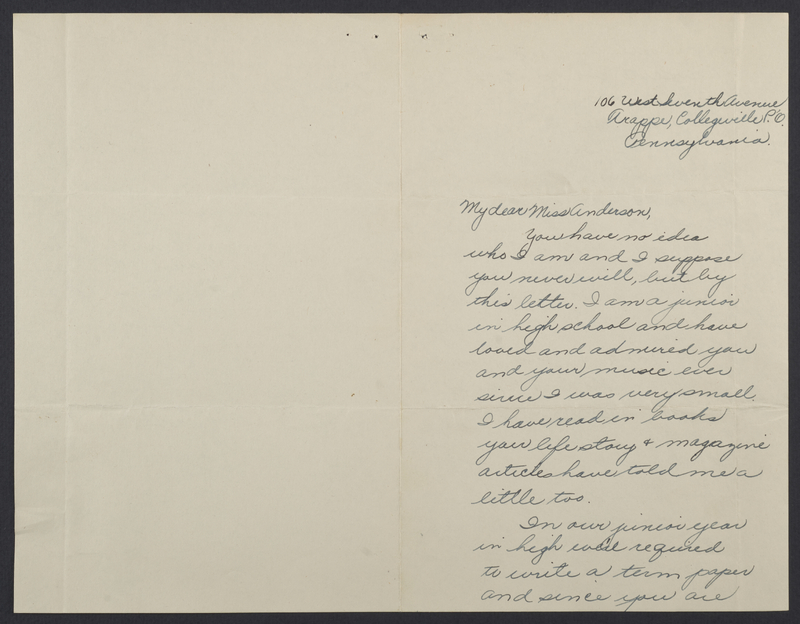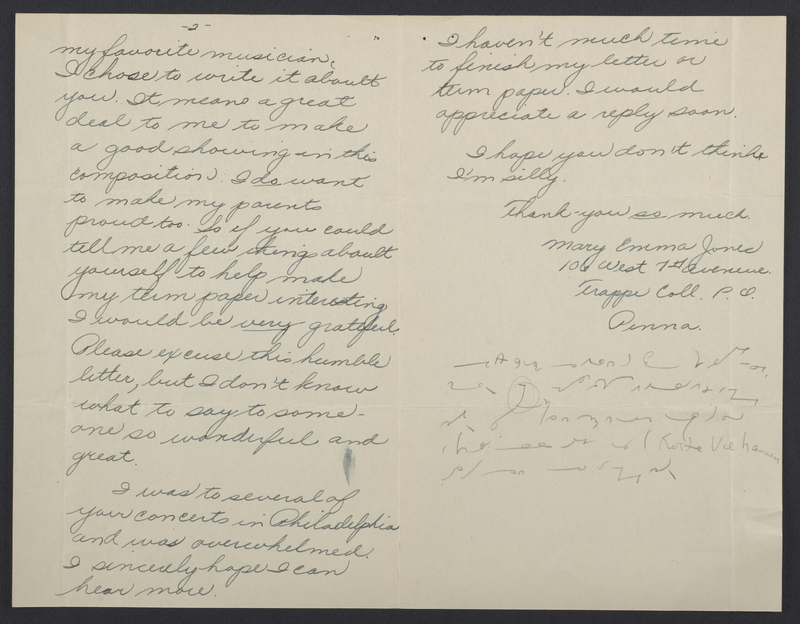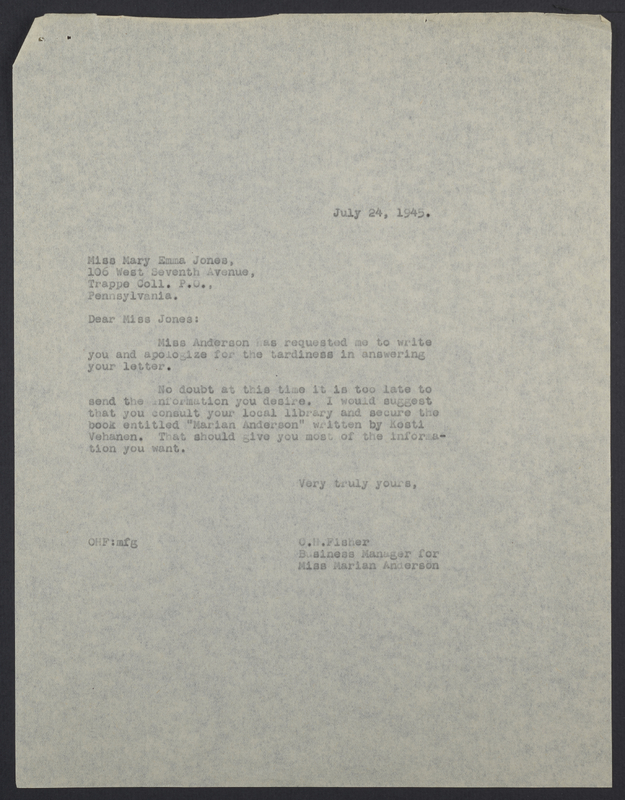Letter, Mary Emma Jones to Miss Anderson, 1945
Item
-
Title
-
Letter, Mary Emma Jones to Miss Anderson, 1945
-
Rights
-
Copyright restrictions may exist. For most library holdings, the Trustees of the University of Pennsylvania do not hold copyright. It is the responsibility of the requester to seek permission from the holder of the copyright to reproduce material from the Kislak Center for Special Collections, Rare Books and Manuscripts.
-
Date
-
1945
-
Description
-
This letter was sent by Mary Emma Jones (1928-) of Trappe, Collegeville, Pennsylvania to Marian Anderson (February 27, 1897-April 8, 1993) in 1945, presumably towards the end of Mary’s junior year at Collegeville Trappe High School. The purpose of this letter is to request compelling information from Anderson so that her junior year term paper would be impressive, and make her parents proud (page 2). Jones repeatedly offers compliments, gratitude, and appreciation to Anderson. She notes that she has attended Anderson’s concerts in Philadelphia, which would be about an hour (roughly 32 miles) from Collegeville, PA.
-
Anderson’s Business Manager Orpheus “King” Hodge Fisher (1900-1986) responded on July 24, 1945, per the request of Anderson. He was also an architect and eventually her husband, married on July 24, 1943 (Tatman 2025; Penn Libraries, n.d.). He apologizes for the tardy reply, and advises her to: “consult her] local library” for the book “Marian Anderson” by Kosti Vehanen. Vehanen (August 31, 1887-March 13, 1957) above all a Finnish pianist and composer, but he also wrote a number of memoirs, one of which being the one Fisher recommended (Discography of American Historical Recordings, n.d.).
Marian Anderson was born and raised in South Philadelphia to John and Anna Anderson, and had two younger sisters (Penn Libraries, n.d.). She would grow up to reach international fame as a contralto classical singer, and symbol of success and resilience (Penn Libraries, n.d.). Her singing career began in her family’s church chorus, and she sang and studied music and performance at William Penn High School and South Philadelphia High School for Girls (Penn Libraries, n.d.). Her church, local organizations, and the greater Black community helped to financially support and advance her early educational journey (Penn Libraries, n.d.). These opportunities and connections propelled her to local and regional fame; having first performed at the Philadelphia Academy of Music in 1918 and with the New York Philharmonic in 1924 (Penn Libraries, n.d.). She studied the arts internationally, making her first trip to Europe in 1928 (Penn Libraries, n.d.). At first funded by foundations and scholarships who saw immense talent in her, Anderson would continue to tour and travel internationally through her career (Marian Anderson Museum, n.d.).
Anderson is appreciated for paving the way for future Black performers, as she was the first Black female to perform at Carnegie Hall in 1928, the first Black singer to perform at the Metropolitan Opera in 1955, and the first Black singer to perform at a Presidential Inauguration in 1957 (Marian Anderson Museum, n.d.). She experienced racism in the United States more than other countries, and gently protested this in ways such as insisting auditorium seating be integrated, and “refus[ing] to sing where the audience was segregated” (National Marian Anderson Museum, n.d.). In 1936, Anderson performed at the White House in Washington, D.C. In 1939, she was to perform again in D.C.– her manager Sol Hurok suggested that she perform at Constitution Hall, the capital’s largest concert hall seating up to 3,702 people (Daughters of the American Revolution, n.d.). It is operated by the Daughters of the American Revolution, and they denied her the opportunity to perform due to the color of her skin (Penn Libraries, n.d.; DAR Public Relations, n.d.). Instead, she performed on Easter for over 75,000 people (plus radio listeners) on the steps of the Lincoln Memorial (National Marian Anderson Museum, n.d.).
Anderson received a plethora of awards, appointments, and over fifty honorary degrees including: an honorary membership in Alpha Kappa Alpha; honorary degrees from Howard University, Temple University, Smith College, and more; NAACP Spingarn Medal in 1939; the Philadelphia Award established by Edward Bok of which was particularly meaningful to her in 1941; appointment to the National Council on the Arts in 1966; the United Nations Peace Prize in 1972; Congressional Medal by President Carter in 1978; as well as the Grammy Lifetime Achievement Award in 1991 (Penn Libraries, n.d.; Anderson 1955, pp. 273-275; Marian Anderson Museum, n.d.).
-
Map to Mary Emma Jones’ address
-
"Marian Anderson, A Portrait" by Kosti Vehanen on the Internet Archive
-
Penn Libraries Digital Collection on Marian Anderson
-
Format
-
Text
-
Language
-
eng
-
Place
-
Collegeville, Pennsylvania
-
Contributor
-
University of Pennsylvania: Kislak Center for Special Collections, Rare Books and Manuscripts
-
Extent
-
4 pages
-
Identifier
-
Ms. Coll. 200 Box 124
-
Subject
-
Anderson, Marian, 1897-1993.
-
Contraltos– United States– Biography.
-
Fan mail--United States.
-
transcription
-
106 West Seventh Avenue Trappe, Collegeville P.'O. Pennsylvania.
My dear Miss Anderson, You have no idea who I am and I suppose you never will, but by this letter. I am a junior in high school and have loved and admired you and your music ever since I was very small. I have read in books your life story & magazine articles have told me a little too.
In our junior year in high we're required to write a term paper and since you are...
(Continued on page 2)






